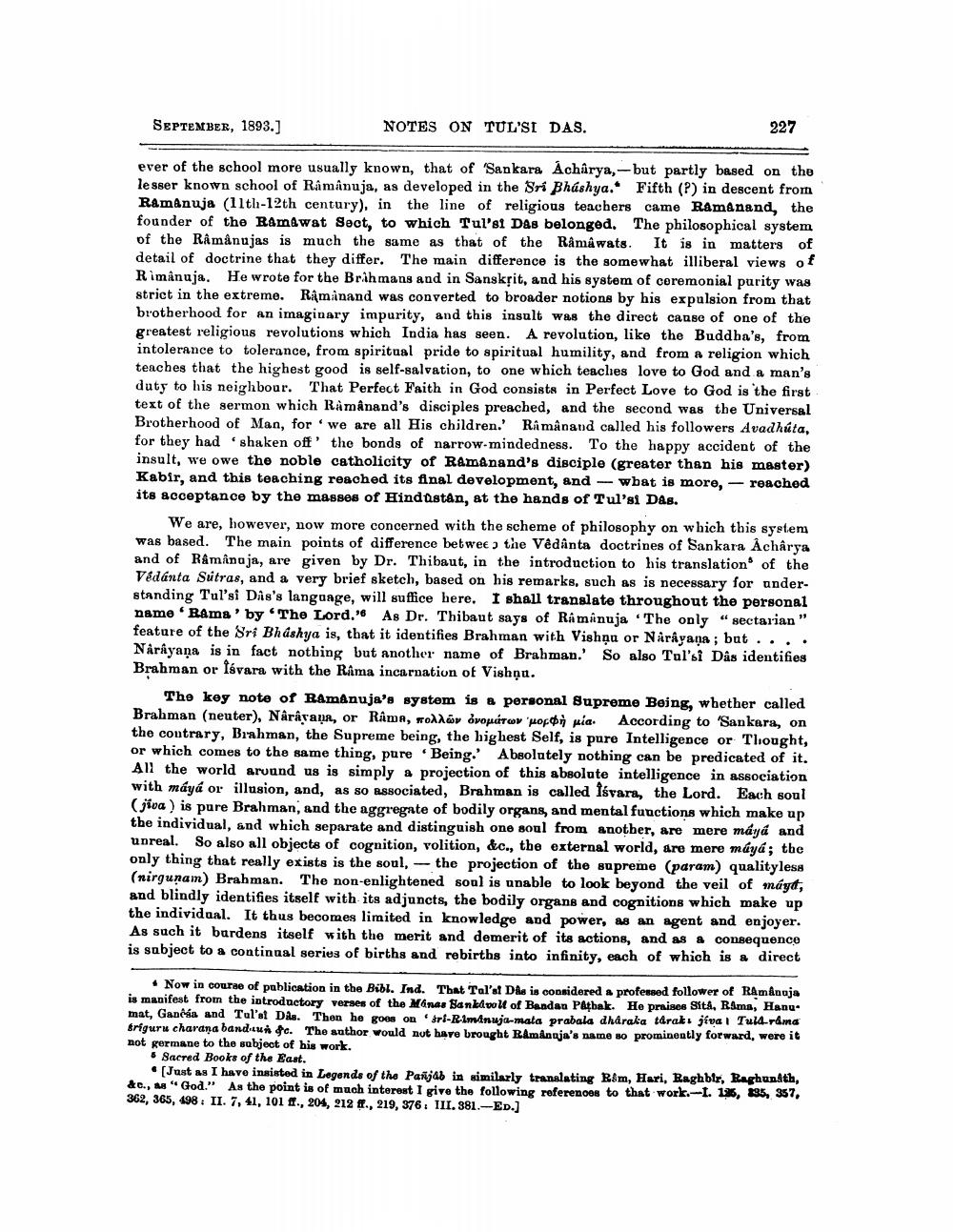________________
SEPTEMBER, 1893.]
ever of the school more usually known, that of 'Sankara Acharya,-but partly based on the lesser known school of Râmânuja, as developed in the Sri Bhashya. Fifth (?) in descent from Ramanuja (11th-12th century), in the line of religious teachers came Ramanand, the founder of the Ramawat Sect, to which Tul'si Das belonged. The philosophical system of the Râmânujas is much the same as that of the Râmâwats. It is in matters of detail of doctrine that they differ. The main difference is the somewhat illiberal views of Rimânuja. He wrote for the Brahmans and in Sanskrit, and his system of ceremonial purity was strict in the extreme. Ramanand was converted to broader notions by his expulsion from that brotherhood for an imaginary impurity, and this insult was the direct cause of one of the greatest religious revolutions which India has seen. A revolution, like the Buddha's, from intolerance to tolerance, from spiritual pride to spiritual humility, and from a religion which teaches that the highest good is self-salvation, to one which teaches love to God and a man's duty to his neighbour. That Perfect Faith in God consists in Perfect Love to God is the first text of the sermon which Râmânand's disciples preached, and the second was the Universal Brotherhood of Man, for we are all His children.' Râmânand called his followers Avadhúta, for they had shaken off the bonds of narrow-mindedness. To the happy accident of the insult, we owe the noble catholicity of Ramanand's disciple (greater than his master) Kabir, and this teaching reached its final development, and what is more, reached its acceptance by the masses of Hindustan, at the hands of Tul'si Das.
"
NOTES ON TUL'SI DAS.
227
We are, however, now more concerned with the scheme of philosophy on which this system was based. The main points of difference betwee the Vêdânta doctrines of Sankara Acharya and of Râmânaja, are given by Dr. Thibaut, in the introduction to his translation of the Védánta Sutras, and a very brief sketch, based on his remarks, such as is necessary for understanding Tul'si Dis's language, will suffice here. I shall translate throughout the personal name Rama' by 'The Lord." As Dr. Thibaut says of Ramanuja The only "sectarian" feature of the Sri Bhashya is, that it identifies Brahman with Vishnu or Narayana; but . . . . Narayana is in fact nothing but another name of Brahman.' So also Tul'si Dâs identifies Brahman or lávara with the Râma incarnation of Vishnu.
The key note of Ramanuja's system is a personal Supreme Being, whether called Brahman (neuter), Nârâvana, or Rama, roddar óvoμárov poft pia. According to 'Sankara, on the contrary, Brahman, the Supreme being, the highest Self, is pure Intelligence or Thought, or which comes to the same thing, pure Being.' Absolutely nothing can be predicated of it. All the world around us is simply a projection of this absolute intelligence in association with máya or illusion, and, as so associated, Brahman is called Isvara, the Lord. Each soul (jiva) is pure Brahman, and the aggregate of bodily organs, and mental functions which make up the individual, and which separate and distinguish one soul from another, are mere máyá and unreal. So also all objects of cognition, volition, &c., the external world, are mere máyá; the only thing that really exists is the soul, the projection of the supreme (param) qualityless (nirgunam) Brahman. The non-enlightened soul is unable to look beyond the veil of máy, and blindly identifies itself with its adjuncts, the bodily organs and cognitions which make up the individual. It thus becomes limited in knowledge and power, as an agent and enjoyer. As such it burdens itself with the merit and demerit of its actions, and as a consequence is subject to a continual series of births and rebirths into infinity, each of which is a direct
-
Now in course of publication in the Bibl. Ind. That Tal's! Dâs is considered a professed follower of Ramanuja is manifest from the introductory verses of the Minas Sankvoll of Bandan Pathak. He praises Sitâ, Rama, Hanu mat, Ganesa and Tul's! Dås. Then he goes on ri-Riminuja-mata prabala dharaka tåraks jiva Tuld-râma Briguru charana bandun &c. The author would not have brought Ramanuja's name so prominently forward, were it not germane to the subject of his work.
Sacred Books of the East.
[Just as I have insisted in Legends of the Panjab in similarly translating Rêm, Hari, Baghblr, Raghunath, &c., as "God." As the point is of much interest I give the following references to that work.-I. 135, 835, 357, 362, 365, 498: II. 7, 41, 101 ff., 204, 212., 219, 376. III. 381.-ED.]




